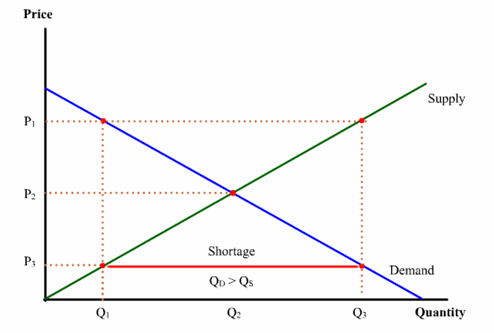Price Signals as Guides for Resource Allocation
High prices for scarce resources ensure that these resources will be used for only high-valued purposes.
The market economy depends on price signals to correctly allocate its scarce resources. Scarce resources should command higher prices than more abundant resources. Guided by correct price signals, resource users will use scarce resources with higher prices for only higher-valued purposes and abundant resources with lower prices for lower-valued purposes.
If prices are absent or set incorrectly, resource users will waste resources by using scarce resources for lower-valued purposes and leaving abundant resources underutilized.
For example, tolls on most toll highways are fixed throughout the day regardless of traffic demand. The toll charge is a price signal to warn off drivers with less urgent needs to use alternative non-toll roads. But the uniform charge does not tell toll-road users when to avoid heavy traffic. Drivers who have less urgent needs to use the toll road at peak hours may innocently join drivers who must use the road at peak hours. This added congestion during peak hours could have been avoided if tolls are set higher than non-peak hours. Presumably, only drivers with more urgent needs would be prepared to pay the higher tolls to use the toll road at peak hours (see Congestion Pricing). In other words, when a scarce resource is priced lower than it should be, it is not reserved for higher-valued purposes and is over-used for lower-valued purposes.
Sometimes, price signals are completely absent. For example, some cities encourage residents to recycle some wastes by having periodic free pickups of separated recyclables. But no payment is made for the collected recyclables. And no extra charge is imposed for having more garbage than the assigned garbage container. So residents are given no price signals as to why they should bother to separate out the recyclables except out of a sense of environmental conscience. As a result, the amount of recycles collected is much less than expected if there were a charge for excess garbage or if residents received payment for their recyclables.
When prices are set artificially above the market-clearing level (namely price support), this price floor would increase quantity supplied and decrease quantity demanded leading to excess supply (also known as surplus). Whenever prices are set artificially below the market-clearing level (namely price control), this price ceiling would increase quantity demanded and decrease quantity supplied leading to excess demand (also known as shortage).
When prices are artificially set at different levels in separate markets for similar goods, arbitrage (if it is legal to move goods from the cheaper market to the more expensive market) or smuggling (if it is illegal to move goods from the cheaper market to the more expensive market) will tend to reduce or eliminate the price differential unless the goods are perishable across market boundaries.
Correct prices that fully reflect resource scarcity are very efficient signals to resource users. Resource users do not have to know how the numerous jig-saw pieces of the market-economy puzzle actually fit together to behave efficiently. All they have to do is to maximize their utility by comparing prices and their own value preferences, given their budget constraint.
Glossary:
- price supportSetting the price above the market-clearing level.

- surplusThe excess of quantity supplied over quantity demanded at a given price. Also known as excess supply.

- price ceilingWhen prices are set artificially below the market-clearing level, the controlled price is a ceiling above which it is not allowed to rise. A price ceiling would result in excess demand or shortage.

- excess demandThe excess of quantity demanded over quantity supplied at a given price. Also known as shortage.

- excess supplyThe excess of quantity supplied over quantity demanded at a given price. Also known as surplus.

- arbitrageThe purchase of goods at a market where prices are lower to sell at a market where the prices are higher. These markets could be separated by geography or time. More generally, it is an attempt to gain profit by exploiting differences in prices, and other market-related conditions for similar products or situations.
- price controlSetting the price below the market-clearing level.

- price floorWhen prices are set artificially above the market-clearing level, the supported price is a floor below which it is not allowed to fall. A price floor would result in excess supply or surplus.

- shortageThe excess of quantity demanded over quantity supplied at a given price. Also known as excess demand.

Topics:
Keywords
congestion, garbage, market, Price signals, recycle, resource allocation, toll
